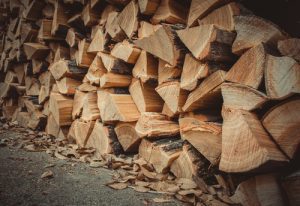Never Spray Firewood with Pesticide!
By Chris Williams on June 16, 2011.
Q. I was relocating a stack of firewood in our yard the other day and found several very large (over an inch long), shiny black beetles in the firewood pile. My wife said I should spray the wood with pesticide now so that it will be safe to use this winter. This doesn’t sound like a good idea to me. Your opinion please?
A. NO, that is not a good idea! Sorry, but tell your wife she is wrong on this one. You should never spray pesticide on firewood that you intend to burn. You won’t find any pesticides labeled for use on wood that will be burned indoors, for good reason. Burning insecticide-treated wood may release toxic fumes into your living space and could be a potential health hazard. It’s not worth the risk since any pesticide probably wouldn’t reach the insects that are tunneling inside the wood anyway.
 There are lots of different insects and arthropods that can make their home in a wood pile. Some are there just temporarily seeking shelter; many pests spend the winter hiding under bark. Other pests (wood-boring beetles, carpenter ants, termites) are actually tunneling into or feeding on the wood. Usually none of them are dangerous (with the possible exception of the black widow spider), and the damage done to the wood is insignificant. If you find a piece of firewood that is infested with wood-boring insects, simply discard it; don’t use it.
There are lots of different insects and arthropods that can make their home in a wood pile. Some are there just temporarily seeking shelter; many pests spend the winter hiding under bark. Other pests (wood-boring beetles, carpenter ants, termites) are actually tunneling into or feeding on the wood. Usually none of them are dangerous (with the possible exception of the black widow spider), and the damage done to the wood is insignificant. If you find a piece of firewood that is infested with wood-boring insects, simply discard it; don’t use it.
The beetles you found are probably Bess beetles, also called patent leather beetles because of their shiny black wing covers. These are very passive, interesting beetles that lives in galleries in decaying logs (which may mean your wood has been sitting too long!).
If your wife is worried about bringing wood pile insects indoors this winter, there are some steps you can take to reduce that risk:
1) The sooner wood is split, the quicker it will dry and be less likely to be infested.
2) Stack firewood up off of the ground and not directly against the house (maybe that’s what you were already doing). Stack the wood in loose piles to dry more quickly.
3) Store wood under cover to keep it dry but leave an air space between wood and the cover.
4) Bring only a few logs at a time into the house.
5) If you want to be extra careful, remove the bark from the logs before bringing them inside.
6) Rotate the wood pile. Don’t let a log remain on the bottom of the pile for more than a year.
7) Burn older wood first. Try not to carry over large amounts of wood from season to season.
Reassure your wife that any pests that do end up inside from the firewood won’t survive long in the drier indoor air and aren’t going to infest wood in your home. They can simply be picked up with a vacuum, or broom and dustpan, and tossed.